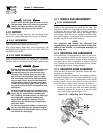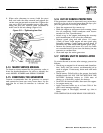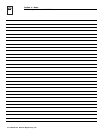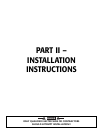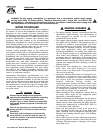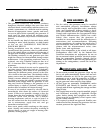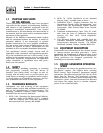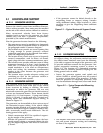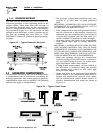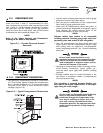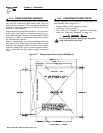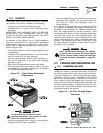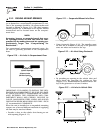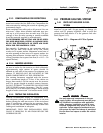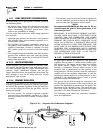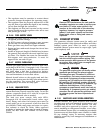
20 Generac
®
Power Systems, Inc.
Section 2 – Installation
IMPACT-36 plus II Recreational Vehicle Generator
2.1.4 GENERATOR RESTRAINT
Use four 5/16"-18 hardened steel bolts (Grade 5) to
fasten the generator to the supporting frame or the
support tubing. These bolts must pass through (a)
the generator mounting base, (b) the compartment
floor, if a compartment is used, and (c) the support-
ing framework (Figure 2.3). All bolts must be long
enough so that when tight, at least 3 threads are vis-
ible past the retaining lock nuts. Refer to “COM-
PARTMENT” section for location of generator mount-
ing holes.
Figure 2.3 — Typical Generator Restraint
2.2 GENERATOR COMPARTMENTS
The generator set may or may not be installed inside
a compartment that is constructed specifically for
housing a generator. This section applies to generator
compartments when they are installed. The following
general rules apply to compartments:
• The generator compartment should be either con-
structed of, or lined with, 26 gauge galvanized
steel.
IMPORTANT: ALUMINUM IS NOT AN ACCEPTABLE
ALTERNATIVE TO GALVANIZED STEEL, DUE TO
ALUMINUM'S LOW MELTING POINT.
• If the compartment is lined with galvanized steel, it
may be constructed of any material. Generac rec-
ommends that the compartment be constructed of
1/2-inch thick plywood, with the floor made of a
double thickness of plywood for added strength.
• All seams, splices and joints of the compartment
walls (unless vapor tight by design) should be
caulked.
IMPORTANT: CAULKING MUST BE DONE SO THAT
THE CAULKING MATERIAL WILL STAY IN PLACE
PERMANENTLY. PRESSING SUCH MATERIALS AS
PUTTY TAPE ONTO JOINTS AND SEAMS WILL NOT
MEET THAT REQUIREMENT. A HIGH QUALITY SIL-
ICONE RUBBER SEALANT IS RECOMMENDED.
• Holes and openings through the compartment
walls for passage of electrical conduit, conductors,
etc, into vehicle living area must be sealed vapor-
tight with silicone rubber base sealant.
• If using flexible metal conduit, seal the conduit at
the end where it terminates inside the junction
box. Flexible metal conduit is NOT vapor tight
along its entire length.
• Seams and joints of the galvanized steel (whether
used as a liner or the compartment itself) must be
lapped and mechanically secured. Such seams
may be manufactured, welded, bolted, riveted, or
screwed. Manufactured lock seams are shown in
Figure 2.4.
◆
Figure 2.4 — Types of Lock Seams



